CPCCBC4011B - Apply Structural Principles to Commercial Low Rise Constructions Assessment 2022
VerifiedAdded on 2022/02/18
|18
|4117
|15
Assignment
AI Summary
Contribute Materials
Your contribution can guide someone’s learning journey. Share your
documents today.
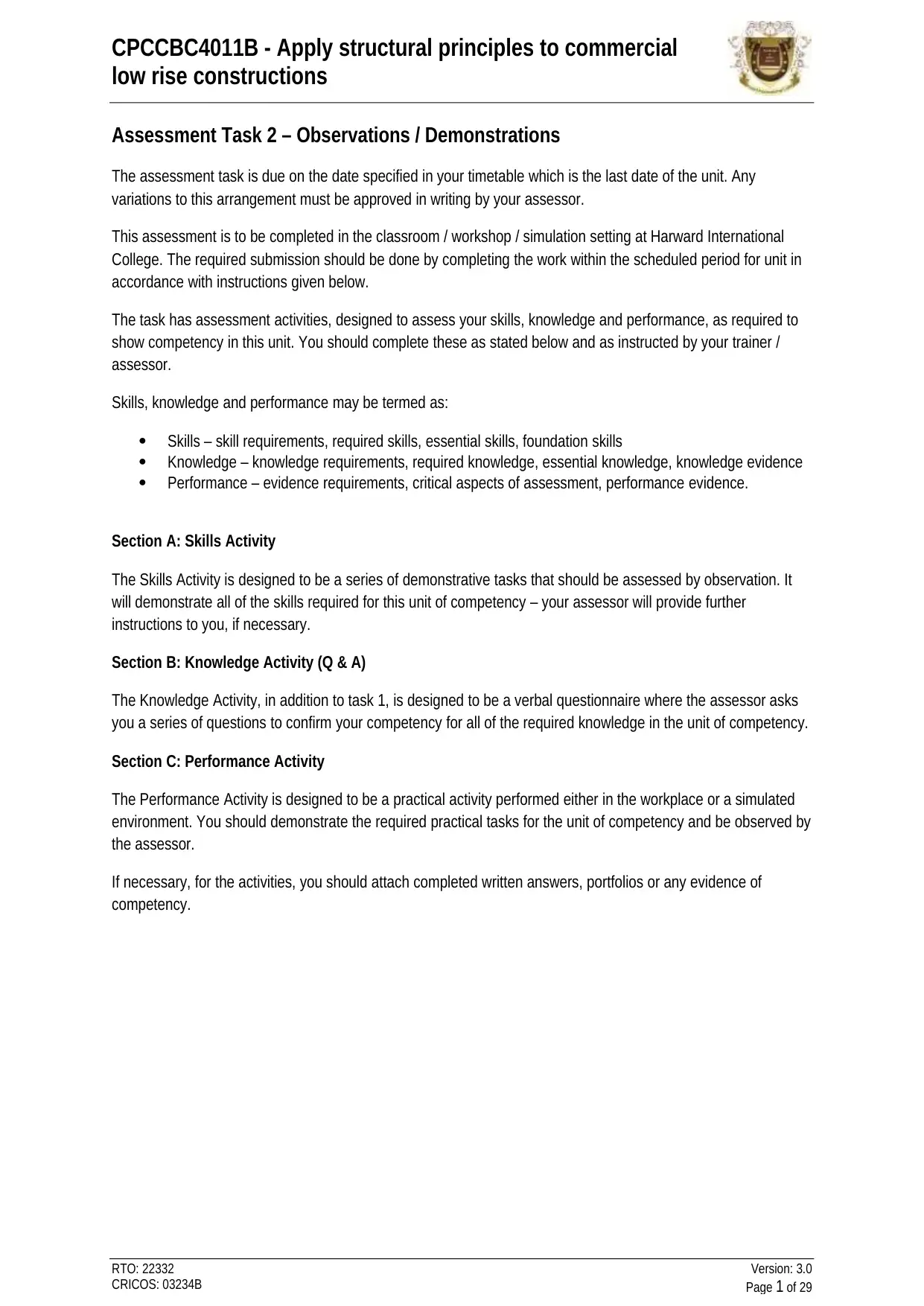
CPCCBC4011B - Apply structural principles to commercial
low rise constructions
RTO: 22332
CRICOS: 03234B
Version: 3.0
Page 1 of 29
Assessment Task 2 – Observations / Demonstrations
The assessment task is due on the date specified in your timetable which is the last date of the unit. Any
variations to this arrangement must be approved in writing by your assessor.
This assessment is to be completed in the classroom / workshop / simulation setting at Harward International
College. The required submission should be done by completing the work within the scheduled period for unit in
accordance with instructions given below.
The task has assessment activities, designed to assess your skills, knowledge and performance, as required to
show competency in this unit. You should complete these as stated below and as instructed by your trainer /
assessor.
Skills, knowledge and performance may be termed as:
Skills – skill requirements, required skills, essential skills, foundation skills
Knowledge – knowledge requirements, required knowledge, essential knowledge, knowledge evidence
Performance – evidence requirements, critical aspects of assessment, performance evidence.
Section A: Skills Activity
The Skills Activity is designed to be a series of demonstrative tasks that should be assessed by observation. It
will demonstrate all of the skills required for this unit of competency – your assessor will provide further
instructions to you, if necessary.
Section B: Knowledge Activity (Q & A)
The Knowledge Activity, in addition to task 1, is designed to be a verbal questionnaire where the assessor asks
you a series of questions to confirm your competency for all of the required knowledge in the unit of competency.
Section C: Performance Activity
The Performance Activity is designed to be a practical activity performed either in the workplace or a simulated
environment. You should demonstrate the required practical tasks for the unit of competency and be observed by
the assessor.
If necessary, for the activities, you should attach completed written answers, portfolios or any evidence of
competency.
low rise constructions
RTO: 22332
CRICOS: 03234B
Version: 3.0
Page 1 of 29
Assessment Task 2 – Observations / Demonstrations
The assessment task is due on the date specified in your timetable which is the last date of the unit. Any
variations to this arrangement must be approved in writing by your assessor.
This assessment is to be completed in the classroom / workshop / simulation setting at Harward International
College. The required submission should be done by completing the work within the scheduled period for unit in
accordance with instructions given below.
The task has assessment activities, designed to assess your skills, knowledge and performance, as required to
show competency in this unit. You should complete these as stated below and as instructed by your trainer /
assessor.
Skills, knowledge and performance may be termed as:
Skills – skill requirements, required skills, essential skills, foundation skills
Knowledge – knowledge requirements, required knowledge, essential knowledge, knowledge evidence
Performance – evidence requirements, critical aspects of assessment, performance evidence.
Section A: Skills Activity
The Skills Activity is designed to be a series of demonstrative tasks that should be assessed by observation. It
will demonstrate all of the skills required for this unit of competency – your assessor will provide further
instructions to you, if necessary.
Section B: Knowledge Activity (Q & A)
The Knowledge Activity, in addition to task 1, is designed to be a verbal questionnaire where the assessor asks
you a series of questions to confirm your competency for all of the required knowledge in the unit of competency.
Section C: Performance Activity
The Performance Activity is designed to be a practical activity performed either in the workplace or a simulated
environment. You should demonstrate the required practical tasks for the unit of competency and be observed by
the assessor.
If necessary, for the activities, you should attach completed written answers, portfolios or any evidence of
competency.
Secure Best Marks with AI Grader
Need help grading? Try our AI Grader for instant feedback on your assignments.
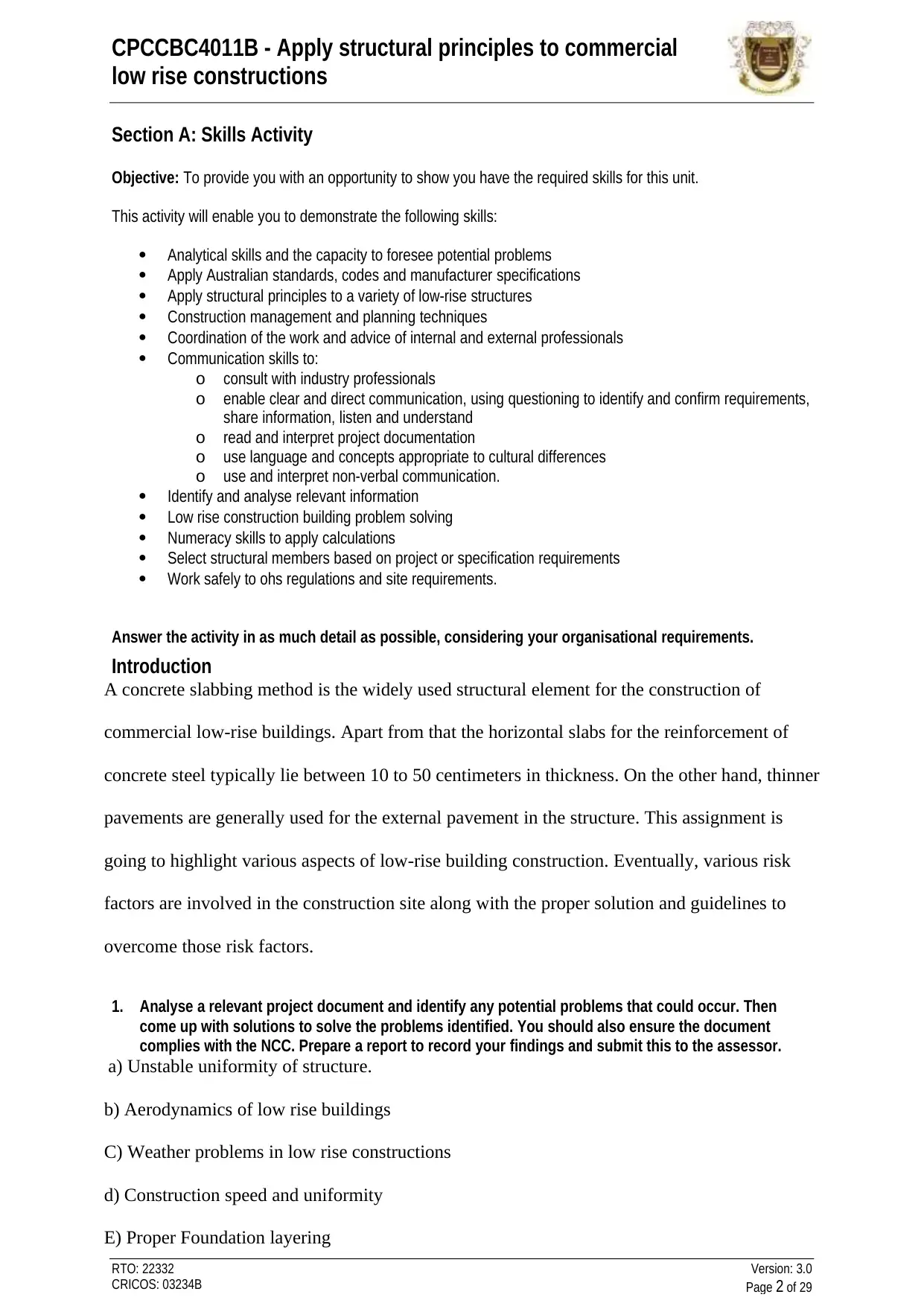
CPCCBC4011B - Apply structural principles to commercial
low rise constructions
RTO: 22332
CRICOS: 03234B
Version: 3.0
Page 2 of 29
Section A: Skills Activity
Objective: To provide you with an opportunity to show you have the required skills for this unit.
This activity will enable you to demonstrate the following skills:
Analytical skills and the capacity to foresee potential problems
Apply Australian standards, codes and manufacturer specifications
Apply structural principles to a variety of low-rise structures
Construction management and planning techniques
Coordination of the work and advice of internal and external professionals
Communication skills to:
o consult with industry professionals
o enable clear and direct communication, using questioning to identify and confirm requirements,
share information, listen and understand
o read and interpret project documentation
o use language and concepts appropriate to cultural differences
o use and interpret non-verbal communication.
Identify and analyse relevant information
Low rise construction building problem solving
Numeracy skills to apply calculations
Select structural members based on project or specification requirements
Work safely to ohs regulations and site requirements.
Answer the activity in as much detail as possible, considering your organisational requirements.
Introduction
A concrete slabbing method is the widely used structural element for the construction of
commercial low-rise buildings. Apart from that the horizontal slabs for the reinforcement of
concrete steel typically lie between 10 to 50 centimeters in thickness. On the other hand, thinner
pavements are generally used for the external pavement in the structure. This assignment is
going to highlight various aspects of low-rise building construction. Eventually, various risk
factors are involved in the construction site along with the proper solution and guidelines to
overcome those risk factors.
1. Analyse a relevant project document and identify any potential problems that could occur. Then
come up with solutions to solve the problems identified. You should also ensure the document
complies with the NCC. Prepare a report to record your findings and submit this to the assessor.
a) Unstable uniformity of structure.
b) Aerodynamics of low rise buildings
C) Weather problems in low rise constructions
d) Construction speed and uniformity
E) Proper Foundation layering
low rise constructions
RTO: 22332
CRICOS: 03234B
Version: 3.0
Page 2 of 29
Section A: Skills Activity
Objective: To provide you with an opportunity to show you have the required skills for this unit.
This activity will enable you to demonstrate the following skills:
Analytical skills and the capacity to foresee potential problems
Apply Australian standards, codes and manufacturer specifications
Apply structural principles to a variety of low-rise structures
Construction management and planning techniques
Coordination of the work and advice of internal and external professionals
Communication skills to:
o consult with industry professionals
o enable clear and direct communication, using questioning to identify and confirm requirements,
share information, listen and understand
o read and interpret project documentation
o use language and concepts appropriate to cultural differences
o use and interpret non-verbal communication.
Identify and analyse relevant information
Low rise construction building problem solving
Numeracy skills to apply calculations
Select structural members based on project or specification requirements
Work safely to ohs regulations and site requirements.
Answer the activity in as much detail as possible, considering your organisational requirements.
Introduction
A concrete slabbing method is the widely used structural element for the construction of
commercial low-rise buildings. Apart from that the horizontal slabs for the reinforcement of
concrete steel typically lie between 10 to 50 centimeters in thickness. On the other hand, thinner
pavements are generally used for the external pavement in the structure. This assignment is
going to highlight various aspects of low-rise building construction. Eventually, various risk
factors are involved in the construction site along with the proper solution and guidelines to
overcome those risk factors.
1. Analyse a relevant project document and identify any potential problems that could occur. Then
come up with solutions to solve the problems identified. You should also ensure the document
complies with the NCC. Prepare a report to record your findings and submit this to the assessor.
a) Unstable uniformity of structure.
b) Aerodynamics of low rise buildings
C) Weather problems in low rise constructions
d) Construction speed and uniformity
E) Proper Foundation layering
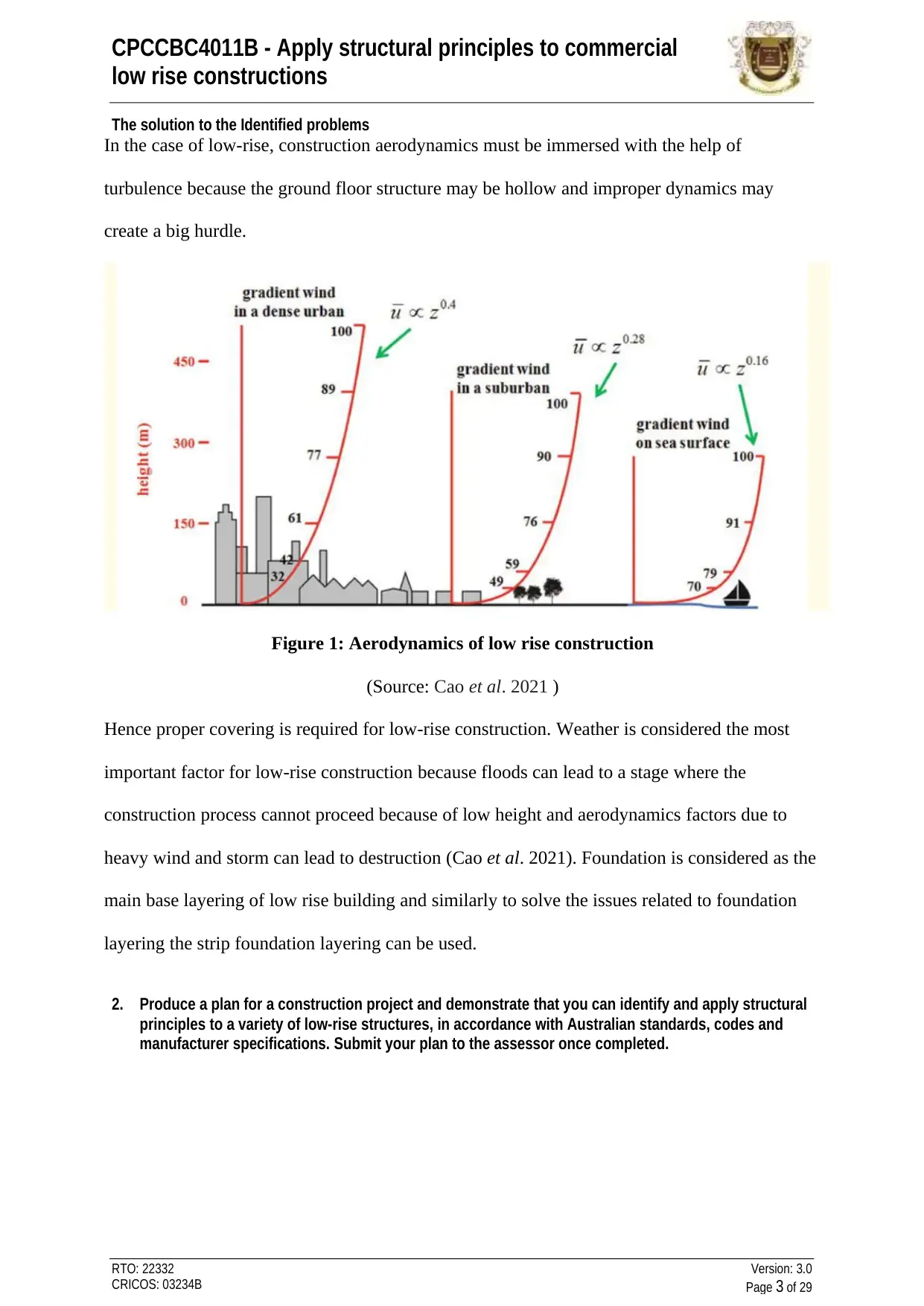
CPCCBC4011B - Apply structural principles to commercial
low rise constructions
RTO: 22332
CRICOS: 03234B
Version: 3.0
Page 3 of 29
The solution to the Identified problems
In the case of low-rise, construction aerodynamics must be immersed with the help of
turbulence because the ground floor structure may be hollow and improper dynamics may
create a big hurdle.
Figure 1: Aerodynamics of low rise construction
(Source: Cao et al. 2021 )
Hence proper covering is required for low-rise construction. Weather is considered the most
important factor for low-rise construction because floods can lead to a stage where the
construction process cannot proceed because of low height and aerodynamics factors due to
heavy wind and storm can lead to destruction (Cao et al. 2021). Foundation is considered as the
main base layering of low rise building and similarly to solve the issues related to foundation
layering the strip foundation layering can be used.
2. Produce a plan for a construction project and demonstrate that you can identify and apply structural
principles to a variety of low-rise structures, in accordance with Australian standards, codes and
manufacturer specifications. Submit your plan to the assessor once completed.
low rise constructions
RTO: 22332
CRICOS: 03234B
Version: 3.0
Page 3 of 29
The solution to the Identified problems
In the case of low-rise, construction aerodynamics must be immersed with the help of
turbulence because the ground floor structure may be hollow and improper dynamics may
create a big hurdle.
Figure 1: Aerodynamics of low rise construction
(Source: Cao et al. 2021 )
Hence proper covering is required for low-rise construction. Weather is considered the most
important factor for low-rise construction because floods can lead to a stage where the
construction process cannot proceed because of low height and aerodynamics factors due to
heavy wind and storm can lead to destruction (Cao et al. 2021). Foundation is considered as the
main base layering of low rise building and similarly to solve the issues related to foundation
layering the strip foundation layering can be used.
2. Produce a plan for a construction project and demonstrate that you can identify and apply structural
principles to a variety of low-rise structures, in accordance with Australian standards, codes and
manufacturer specifications. Submit your plan to the assessor once completed.
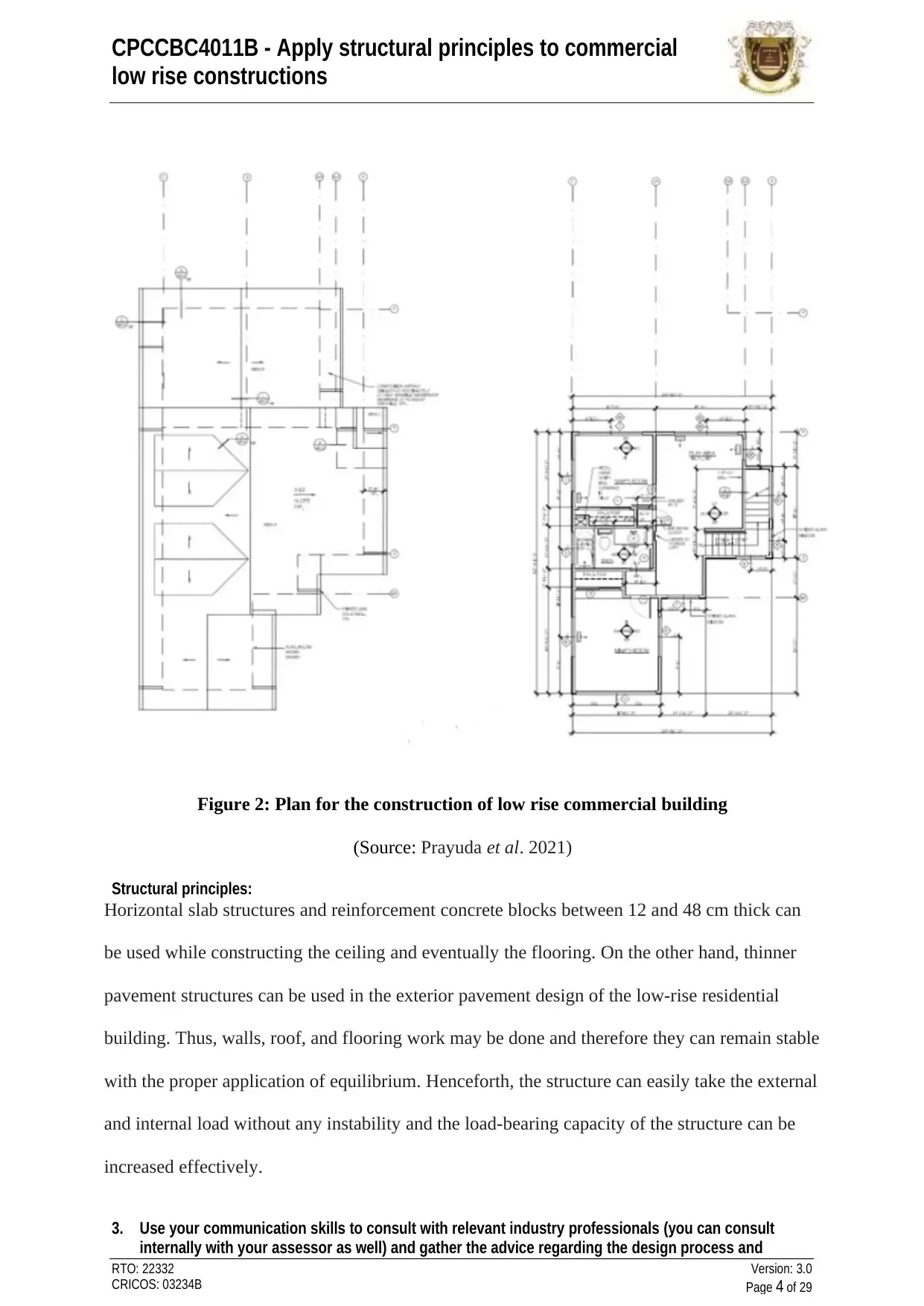
CPCCBC4011B - Apply structural principles to commercial
low rise constructions
RTO: 22332
CRICOS: 03234B
Version: 3.0
Page 4 of 29
Figure 2: Plan for the construction of low rise commercial building
(Source: Prayuda et al. 2021)
Structural principles:
Horizontal slab structures and reinforcement concrete blocks between 12 and 48 cm thick can
be used while constructing the ceiling and eventually the flooring. On the other hand, thinner
pavement structures can be used in the exterior pavement design of the low-rise residential
building. Thus, walls, roof, and flooring work may be done and therefore they can remain stable
with the proper application of equilibrium. Henceforth, the structure can easily take the external
and internal load without any instability and the load-bearing capacity of the structure can be
increased effectively.
3. Use your communication skills to consult with relevant industry professionals (you can consult
internally with your assessor as well) and gather the advice regarding the design process and
low rise constructions
RTO: 22332
CRICOS: 03234B
Version: 3.0
Page 4 of 29
Figure 2: Plan for the construction of low rise commercial building
(Source: Prayuda et al. 2021)
Structural principles:
Horizontal slab structures and reinforcement concrete blocks between 12 and 48 cm thick can
be used while constructing the ceiling and eventually the flooring. On the other hand, thinner
pavement structures can be used in the exterior pavement design of the low-rise residential
building. Thus, walls, roof, and flooring work may be done and therefore they can remain stable
with the proper application of equilibrium. Henceforth, the structure can easily take the external
and internal load without any instability and the load-bearing capacity of the structure can be
increased effectively.
3. Use your communication skills to consult with relevant industry professionals (you can consult
internally with your assessor as well) and gather the advice regarding the design process and
Secure Best Marks with AI Grader
Need help grading? Try our AI Grader for instant feedback on your assignments.
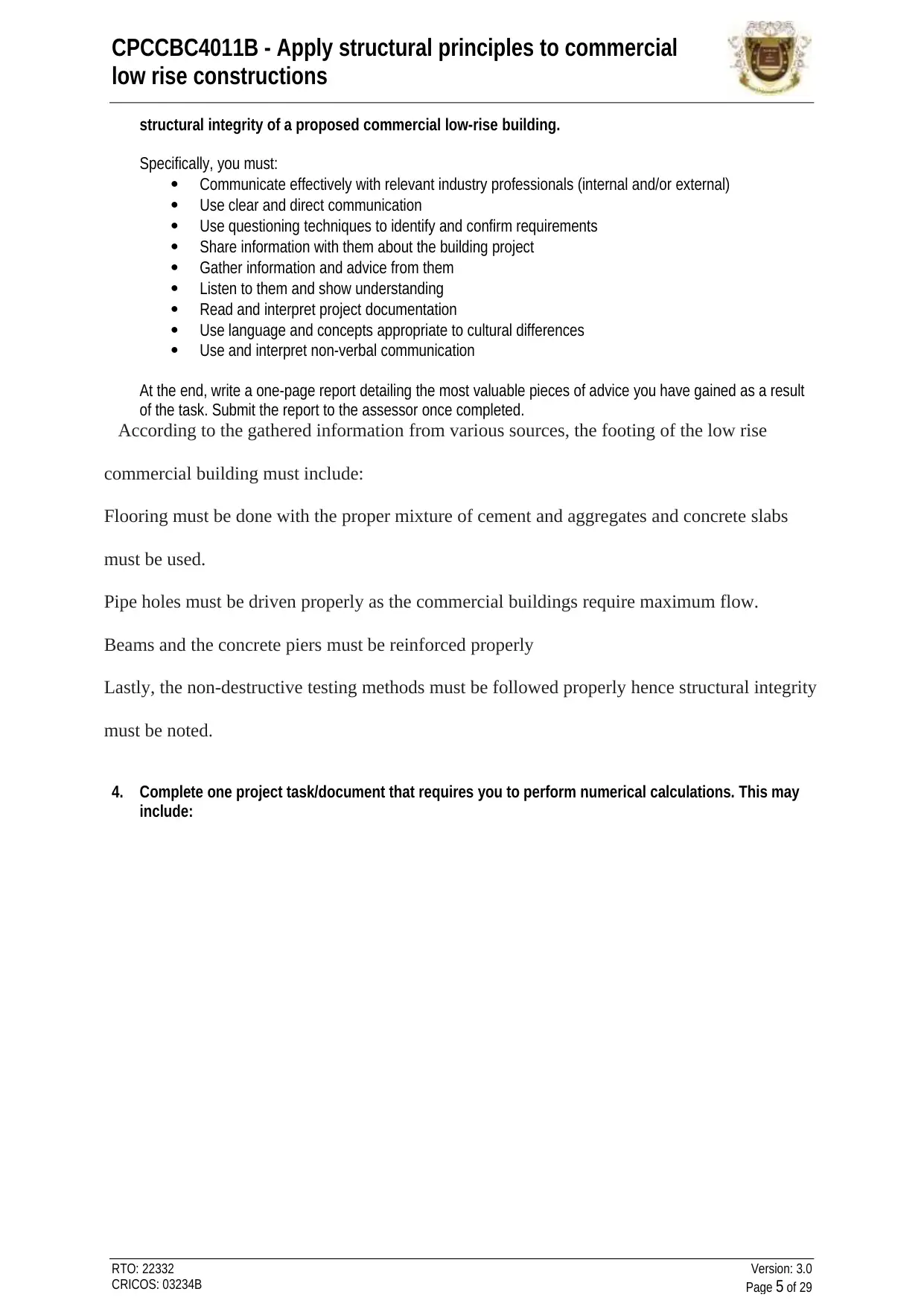
CPCCBC4011B - Apply structural principles to commercial
low rise constructions
RTO: 22332
CRICOS: 03234B
Version: 3.0
Page 5 of 29
structural integrity of a proposed commercial low-rise building.
Specifically, you must:
Communicate effectively with relevant industry professionals (internal and/or external)
Use clear and direct communication
Use questioning techniques to identify and confirm requirements
Share information with them about the building project
Gather information and advice from them
Listen to them and show understanding
Read and interpret project documentation
Use language and concepts appropriate to cultural differences
Use and interpret non-verbal communication
At the end, write a one-page report detailing the most valuable pieces of advice you have gained as a result
of the task. Submit the report to the assessor once completed.
According to the gathered information from various sources, the footing of the low rise
commercial building must include:
Flooring must be done with the proper mixture of cement and aggregates and concrete slabs
must be used.
Pipe holes must be driven properly as the commercial buildings require maximum flow.
Beams and the concrete piers must be reinforced properly
Lastly, the non-destructive testing methods must be followed properly hence structural integrity
must be noted.
4. Complete one project task/document that requires you to perform numerical calculations. This may
include:
low rise constructions
RTO: 22332
CRICOS: 03234B
Version: 3.0
Page 5 of 29
structural integrity of a proposed commercial low-rise building.
Specifically, you must:
Communicate effectively with relevant industry professionals (internal and/or external)
Use clear and direct communication
Use questioning techniques to identify and confirm requirements
Share information with them about the building project
Gather information and advice from them
Listen to them and show understanding
Read and interpret project documentation
Use language and concepts appropriate to cultural differences
Use and interpret non-verbal communication
At the end, write a one-page report detailing the most valuable pieces of advice you have gained as a result
of the task. Submit the report to the assessor once completed.
According to the gathered information from various sources, the footing of the low rise
commercial building must include:
Flooring must be done with the proper mixture of cement and aggregates and concrete slabs
must be used.
Pipe holes must be driven properly as the commercial buildings require maximum flow.
Beams and the concrete piers must be reinforced properly
Lastly, the non-destructive testing methods must be followed properly hence structural integrity
must be noted.
4. Complete one project task/document that requires you to perform numerical calculations. This may
include:
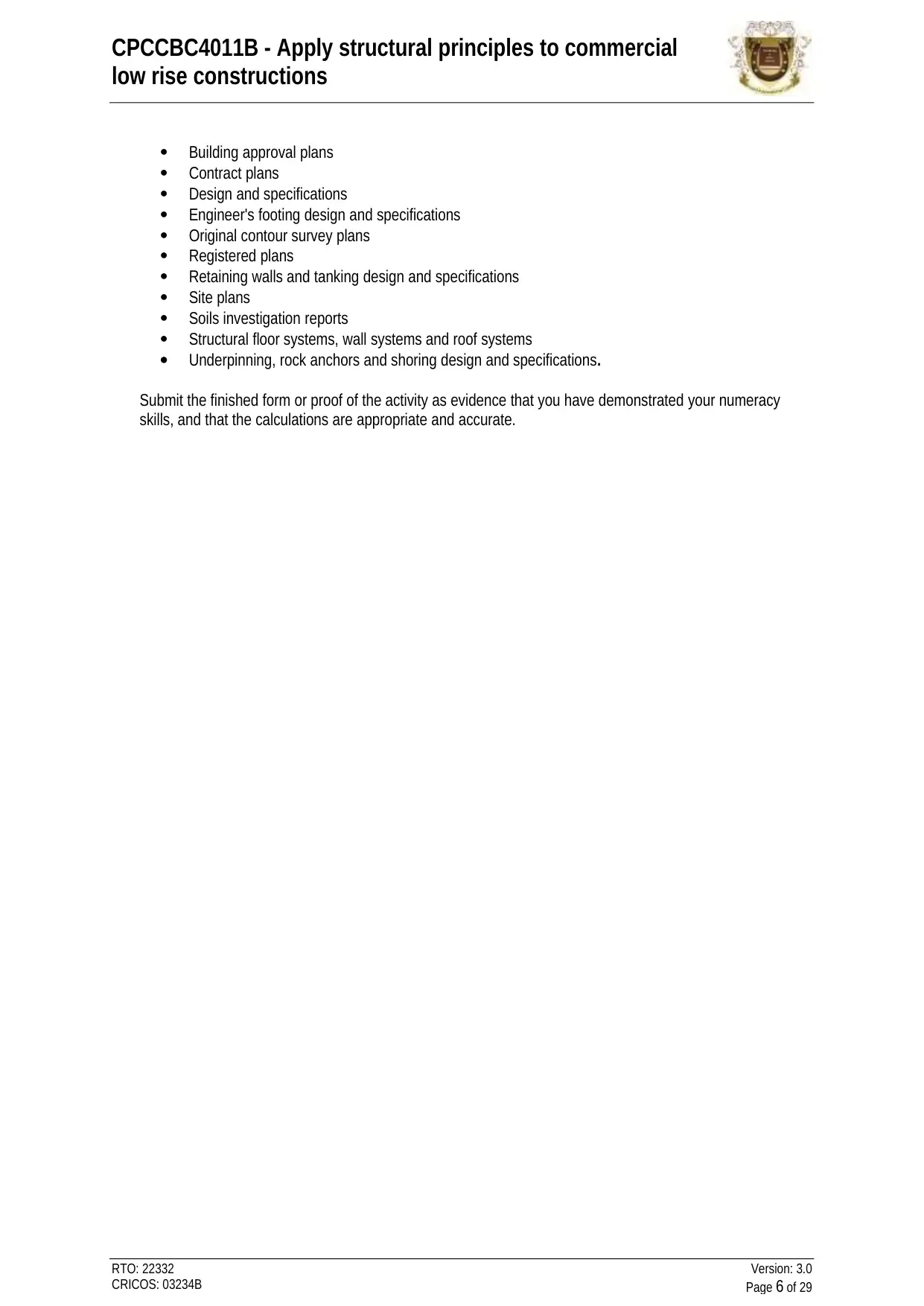
CPCCBC4011B - Apply structural principles to commercial
low rise constructions
RTO: 22332
CRICOS: 03234B
Version: 3.0
Page 6 of 29
Building approval plans
Contract plans
Design and specifications
Engineer's footing design and specifications
Original contour survey plans
Registered plans
Retaining walls and tanking design and specifications
Site plans
Soils investigation reports
Structural floor systems, wall systems and roof systems
Underpinning, rock anchors and shoring design and specifications.
Submit the finished form or proof of the activity as evidence that you have demonstrated your numeracy
skills, and that the calculations are appropriate and accurate.
low rise constructions
RTO: 22332
CRICOS: 03234B
Version: 3.0
Page 6 of 29
Building approval plans
Contract plans
Design and specifications
Engineer's footing design and specifications
Original contour survey plans
Registered plans
Retaining walls and tanking design and specifications
Site plans
Soils investigation reports
Structural floor systems, wall systems and roof systems
Underpinning, rock anchors and shoring design and specifications.
Submit the finished form or proof of the activity as evidence that you have demonstrated your numeracy
skills, and that the calculations are appropriate and accurate.
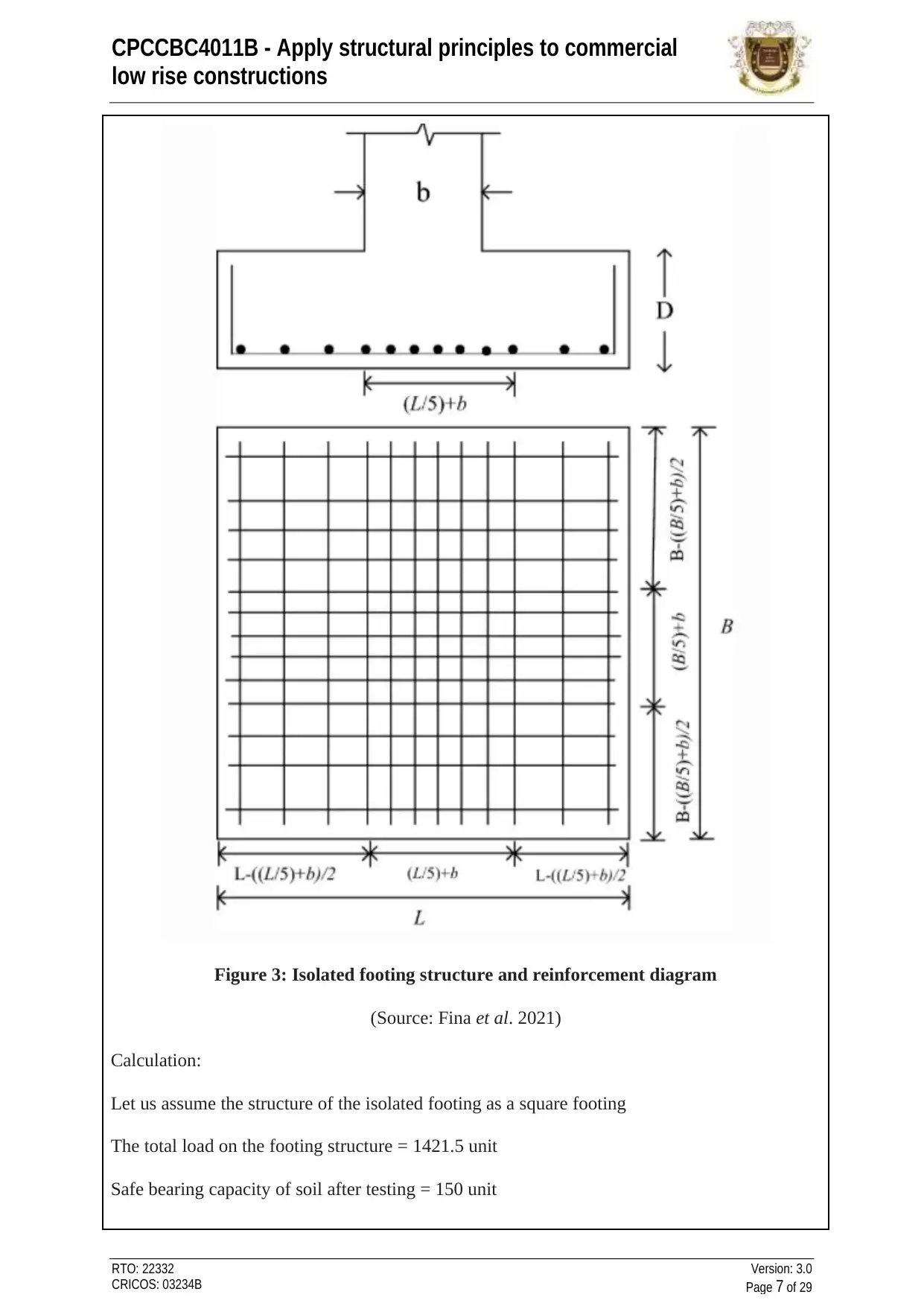
CPCCBC4011B - Apply structural principles to commercial
low rise constructions
RTO: 22332
CRICOS: 03234B
Version: 3.0
Page 7 of 29
Figure 3: Isolated footing structure and reinforcement diagram
(Source: Fina et al. 2021)
Calculation:
Let us assume the structure of the isolated footing as a square footing
The total load on the footing structure = 1421.5 unit
Safe bearing capacity of soil after testing = 150 unit
low rise constructions
RTO: 22332
CRICOS: 03234B
Version: 3.0
Page 7 of 29
Figure 3: Isolated footing structure and reinforcement diagram
(Source: Fina et al. 2021)
Calculation:
Let us assume the structure of the isolated footing as a square footing
The total load on the footing structure = 1421.5 unit
Safe bearing capacity of soil after testing = 150 unit
Paraphrase This Document
Need a fresh take? Get an instant paraphrase of this document with our AI Paraphraser
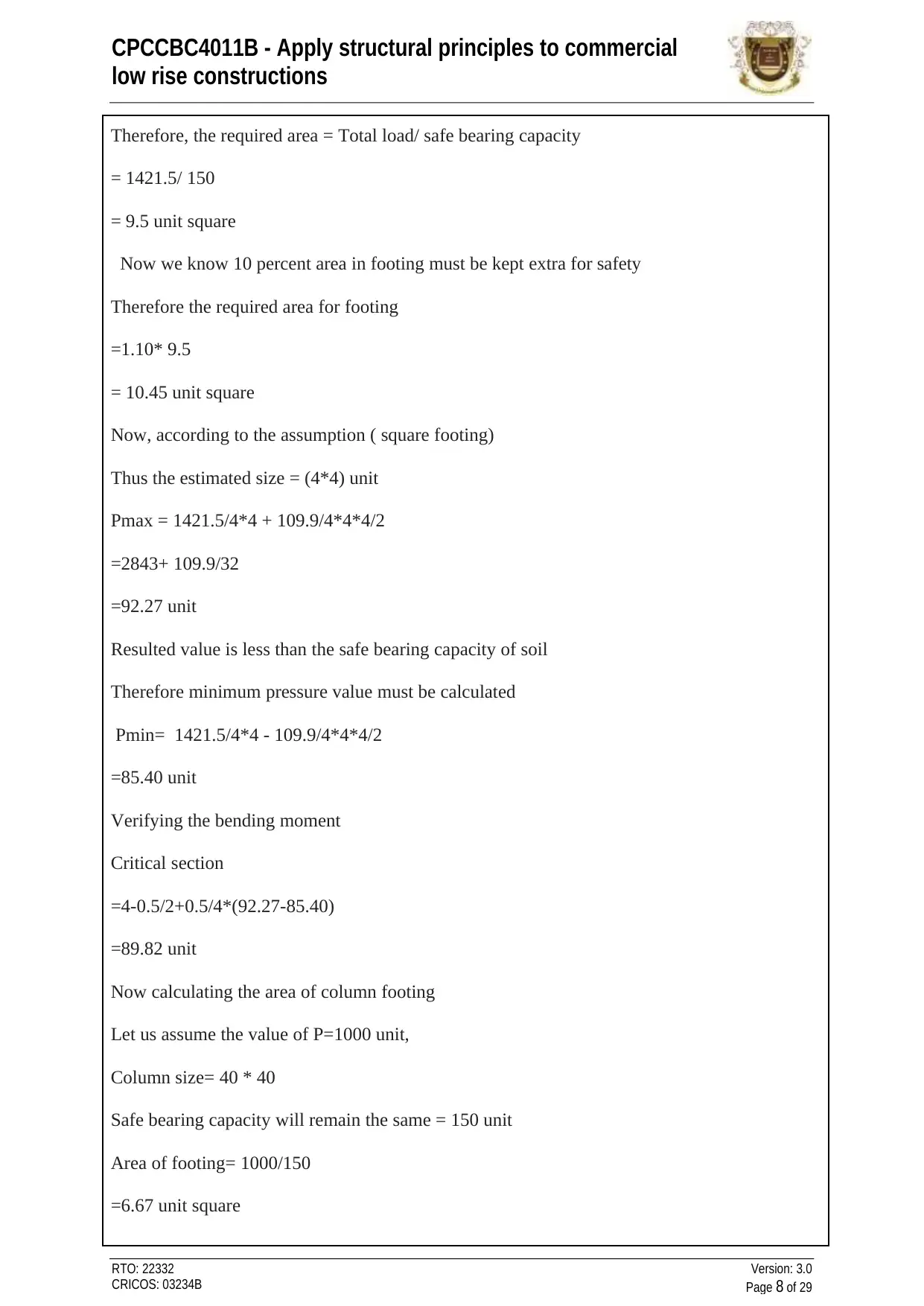
CPCCBC4011B - Apply structural principles to commercial
low rise constructions
RTO: 22332
CRICOS: 03234B
Version: 3.0
Page 8 of 29
Therefore, the required area = Total load/ safe bearing capacity
= 1421.5/ 150
= 9.5 unit square
Now we know 10 percent area in footing must be kept extra for safety
Therefore the required area for footing
=1.10* 9.5
= 10.45 unit square
Now, according to the assumption ( square footing)
Thus the estimated size = (4*4) unit
Pmax = 1421.5/4*4 + 109.9/4*4*4/2
=2843+ 109.9/32
=92.27 unit
Resulted value is less than the safe bearing capacity of soil
Therefore minimum pressure value must be calculated
Pmin= 1421.5/4*4 - 109.9/4*4*4/2
=85.40 unit
Verifying the bending moment
Critical section
=4-0.5/2+0.5/4*(92.27-85.40)
=89.82 unit
Now calculating the area of column footing
Let us assume the value of P=1000 unit,
Column size= 40 * 40
Safe bearing capacity will remain the same = 150 unit
Area of footing= 1000/150
=6.67 unit square
low rise constructions
RTO: 22332
CRICOS: 03234B
Version: 3.0
Page 8 of 29
Therefore, the required area = Total load/ safe bearing capacity
= 1421.5/ 150
= 9.5 unit square
Now we know 10 percent area in footing must be kept extra for safety
Therefore the required area for footing
=1.10* 9.5
= 10.45 unit square
Now, according to the assumption ( square footing)
Thus the estimated size = (4*4) unit
Pmax = 1421.5/4*4 + 109.9/4*4*4/2
=2843+ 109.9/32
=92.27 unit
Resulted value is less than the safe bearing capacity of soil
Therefore minimum pressure value must be calculated
Pmin= 1421.5/4*4 - 109.9/4*4*4/2
=85.40 unit
Verifying the bending moment
Critical section
=4-0.5/2+0.5/4*(92.27-85.40)
=89.82 unit
Now calculating the area of column footing
Let us assume the value of P=1000 unit,
Column size= 40 * 40
Safe bearing capacity will remain the same = 150 unit
Area of footing= 1000/150
=6.67 unit square
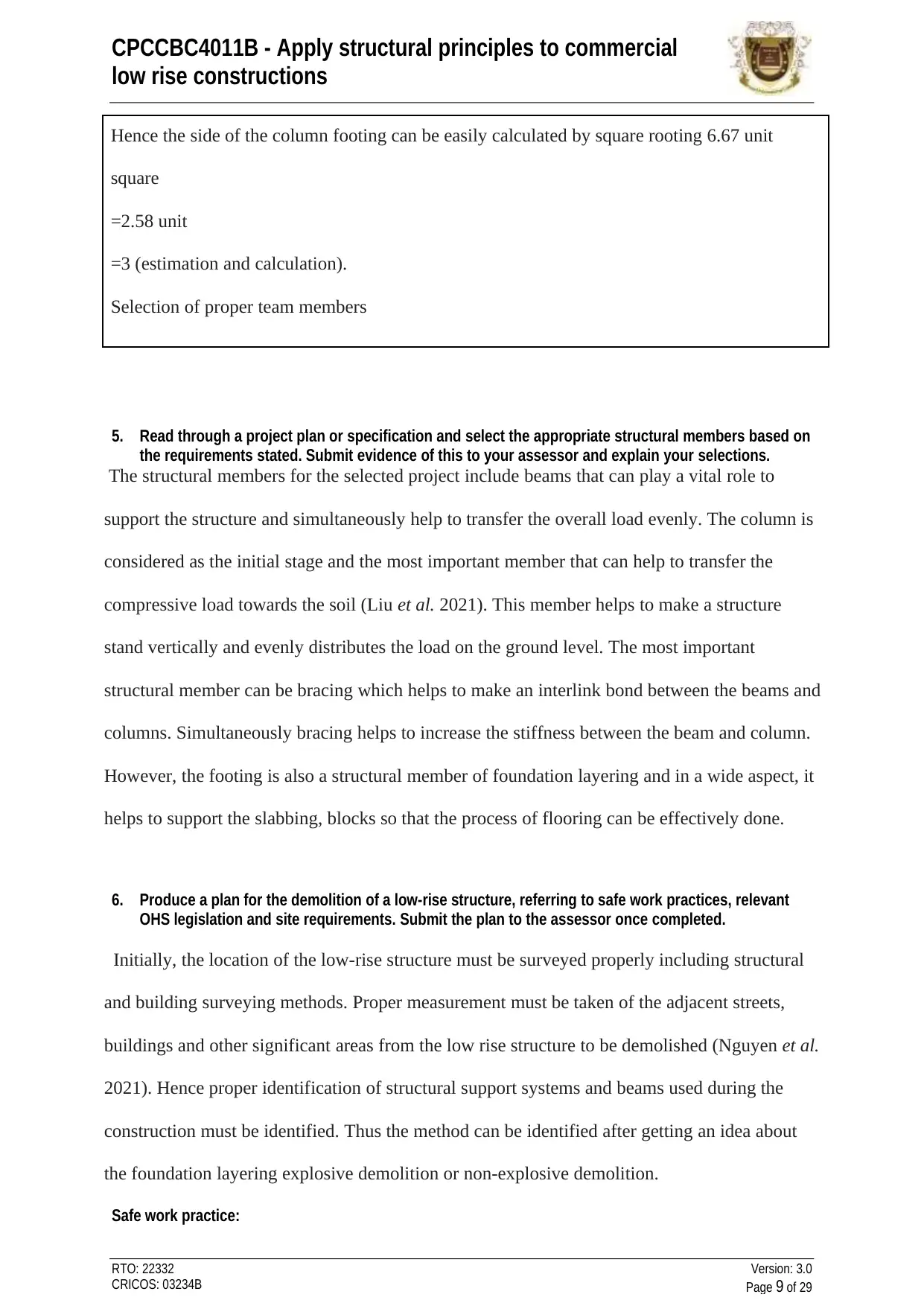
CPCCBC4011B - Apply structural principles to commercial
low rise constructions
RTO: 22332
CRICOS: 03234B
Version: 3.0
Page 9 of 29
Hence the side of the column footing can be easily calculated by square rooting 6.67 unit
square
=2.58 unit
=3 (estimation and calculation).
Selection of proper team members
5. Read through a project plan or specification and select the appropriate structural members based on
the requirements stated. Submit evidence of this to your assessor and explain your selections.
The structural members for the selected project include beams that can play a vital role to
support the structure and simultaneously help to transfer the overall load evenly. The column is
considered as the initial stage and the most important member that can help to transfer the
compressive load towards the soil (Liu et al. 2021). This member helps to make a structure
stand vertically and evenly distributes the load on the ground level. The most important
structural member can be bracing which helps to make an interlink bond between the beams and
columns. Simultaneously bracing helps to increase the stiffness between the beam and column.
However, the footing is also a structural member of foundation layering and in a wide aspect, it
helps to support the slabbing, blocks so that the process of flooring can be effectively done.
6. Produce a plan for the demolition of a low-rise structure, referring to safe work practices, relevant
OHS legislation and site requirements. Submit the plan to the assessor once completed.
Initially, the location of the low-rise structure must be surveyed properly including structural
and building surveying methods. Proper measurement must be taken of the adjacent streets,
buildings and other significant areas from the low rise structure to be demolished (Nguyen et al.
2021). Hence proper identification of structural support systems and beams used during the
construction must be identified. Thus the method can be identified after getting an idea about
the foundation layering explosive demolition or non-explosive demolition.
Safe work practice:
low rise constructions
RTO: 22332
CRICOS: 03234B
Version: 3.0
Page 9 of 29
Hence the side of the column footing can be easily calculated by square rooting 6.67 unit
square
=2.58 unit
=3 (estimation and calculation).
Selection of proper team members
5. Read through a project plan or specification and select the appropriate structural members based on
the requirements stated. Submit evidence of this to your assessor and explain your selections.
The structural members for the selected project include beams that can play a vital role to
support the structure and simultaneously help to transfer the overall load evenly. The column is
considered as the initial stage and the most important member that can help to transfer the
compressive load towards the soil (Liu et al. 2021). This member helps to make a structure
stand vertically and evenly distributes the load on the ground level. The most important
structural member can be bracing which helps to make an interlink bond between the beams and
columns. Simultaneously bracing helps to increase the stiffness between the beam and column.
However, the footing is also a structural member of foundation layering and in a wide aspect, it
helps to support the slabbing, blocks so that the process of flooring can be effectively done.
6. Produce a plan for the demolition of a low-rise structure, referring to safe work practices, relevant
OHS legislation and site requirements. Submit the plan to the assessor once completed.
Initially, the location of the low-rise structure must be surveyed properly including structural
and building surveying methods. Proper measurement must be taken of the adjacent streets,
buildings and other significant areas from the low rise structure to be demolished (Nguyen et al.
2021). Hence proper identification of structural support systems and beams used during the
construction must be identified. Thus the method can be identified after getting an idea about
the foundation layering explosive demolition or non-explosive demolition.
Safe work practice:
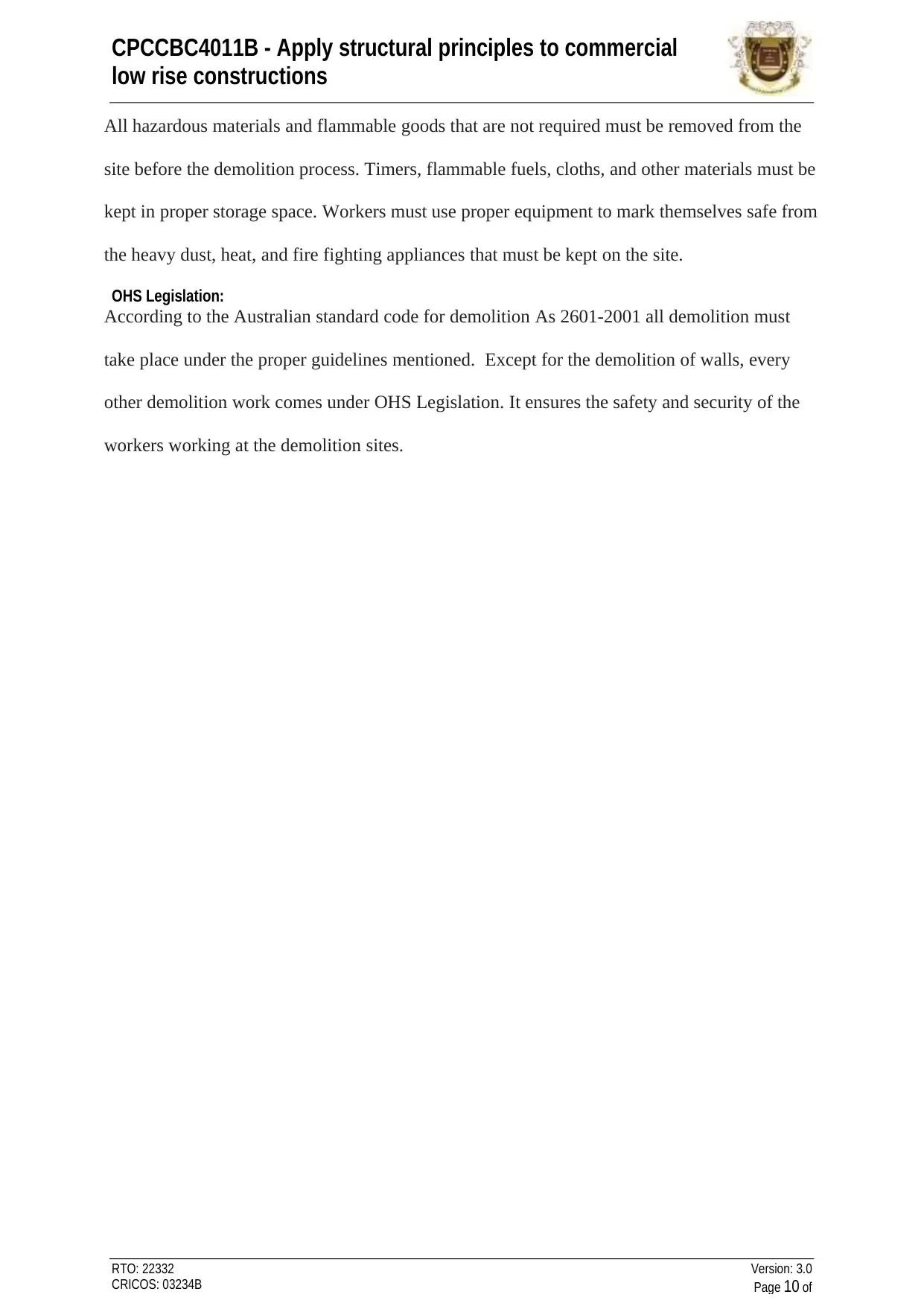
CPCCBC4011B - Apply structural principles to commercial
low rise constructions
RTO: 22332
CRICOS: 03234B
Version: 3.0
Page 10 of
All hazardous materials and flammable goods that are not required must be removed from the
site before the demolition process. Timers, flammable fuels, cloths, and other materials must be
kept in proper storage space. Workers must use proper equipment to mark themselves safe from
the heavy dust, heat, and fire fighting appliances that must be kept on the site.
OHS Legislation:
According to the Australian standard code for demolition As 2601-2001 all demolition must
take place under the proper guidelines mentioned. Except for the demolition of walls, every
other demolition work comes under OHS Legislation. It ensures the safety and security of the
workers working at the demolition sites.
low rise constructions
RTO: 22332
CRICOS: 03234B
Version: 3.0
Page 10 of
All hazardous materials and flammable goods that are not required must be removed from the
site before the demolition process. Timers, flammable fuels, cloths, and other materials must be
kept in proper storage space. Workers must use proper equipment to mark themselves safe from
the heavy dust, heat, and fire fighting appliances that must be kept on the site.
OHS Legislation:
According to the Australian standard code for demolition As 2601-2001 all demolition must
take place under the proper guidelines mentioned. Except for the demolition of walls, every
other demolition work comes under OHS Legislation. It ensures the safety and security of the
workers working at the demolition sites.
Secure Best Marks with AI Grader
Need help grading? Try our AI Grader for instant feedback on your assignments.
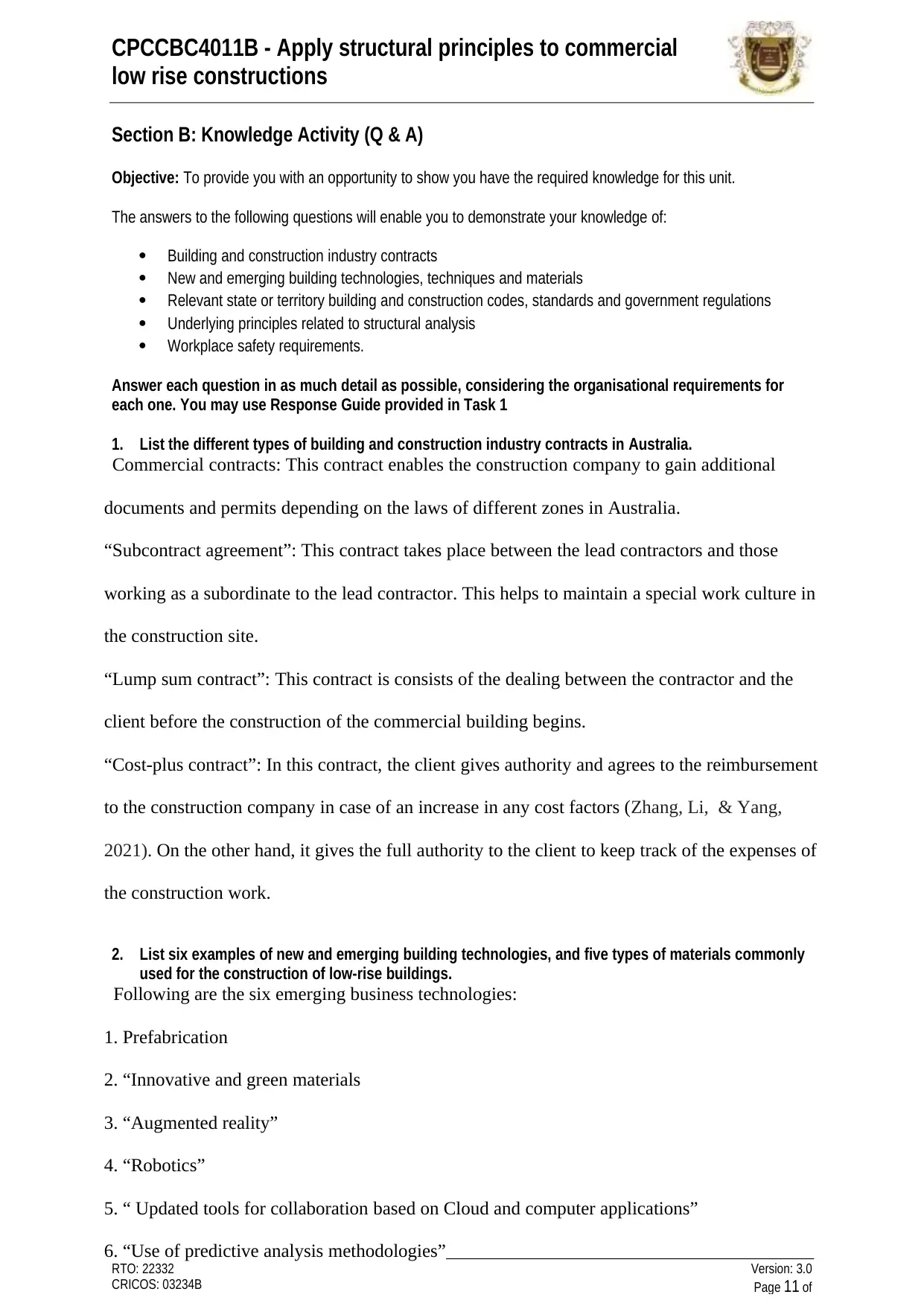
CPCCBC4011B - Apply structural principles to commercial
low rise constructions
RTO: 22332
CRICOS: 03234B
Version: 3.0
Page 11 of
Section B: Knowledge Activity (Q & A)
Objective: To provide you with an opportunity to show you have the required knowledge for this unit.
The answers to the following questions will enable you to demonstrate your knowledge of:
Building and construction industry contracts
New and emerging building technologies, techniques and materials
Relevant state or territory building and construction codes, standards and government regulations
Underlying principles related to structural analysis
Workplace safety requirements.
Answer each question in as much detail as possible, considering the organisational requirements for
each one. You may use Response Guide provided in Task 1
1. List the different types of building and construction industry contracts in Australia.
Commercial contracts: This contract enables the construction company to gain additional
documents and permits depending on the laws of different zones in Australia.
“Subcontract agreement”: This contract takes place between the lead contractors and those
working as a subordinate to the lead contractor. This helps to maintain a special work culture in
the construction site.
“Lump sum contract”: This contract is consists of the dealing between the contractor and the
client before the construction of the commercial building begins.
“Cost-plus contract”: In this contract, the client gives authority and agrees to the reimbursement
to the construction company in case of an increase in any cost factors (Zhang, Li, & Yang,
2021). On the other hand, it gives the full authority to the client to keep track of the expenses of
the construction work.
2. List six examples of new and emerging building technologies, and five types of materials commonly
used for the construction of low-rise buildings.
Following are the six emerging business technologies:
1. Prefabrication
2. “Innovative and green materials
3. “Augmented reality”
4. “Robotics”
5. “ Updated tools for collaboration based on Cloud and computer applications”
6. “Use of predictive analysis methodologies”
low rise constructions
RTO: 22332
CRICOS: 03234B
Version: 3.0
Page 11 of
Section B: Knowledge Activity (Q & A)
Objective: To provide you with an opportunity to show you have the required knowledge for this unit.
The answers to the following questions will enable you to demonstrate your knowledge of:
Building and construction industry contracts
New and emerging building technologies, techniques and materials
Relevant state or territory building and construction codes, standards and government regulations
Underlying principles related to structural analysis
Workplace safety requirements.
Answer each question in as much detail as possible, considering the organisational requirements for
each one. You may use Response Guide provided in Task 1
1. List the different types of building and construction industry contracts in Australia.
Commercial contracts: This contract enables the construction company to gain additional
documents and permits depending on the laws of different zones in Australia.
“Subcontract agreement”: This contract takes place between the lead contractors and those
working as a subordinate to the lead contractor. This helps to maintain a special work culture in
the construction site.
“Lump sum contract”: This contract is consists of the dealing between the contractor and the
client before the construction of the commercial building begins.
“Cost-plus contract”: In this contract, the client gives authority and agrees to the reimbursement
to the construction company in case of an increase in any cost factors (Zhang, Li, & Yang,
2021). On the other hand, it gives the full authority to the client to keep track of the expenses of
the construction work.
2. List six examples of new and emerging building technologies, and five types of materials commonly
used for the construction of low-rise buildings.
Following are the six emerging business technologies:
1. Prefabrication
2. “Innovative and green materials
3. “Augmented reality”
4. “Robotics”
5. “ Updated tools for collaboration based on Cloud and computer applications”
6. “Use of predictive analysis methodologies”
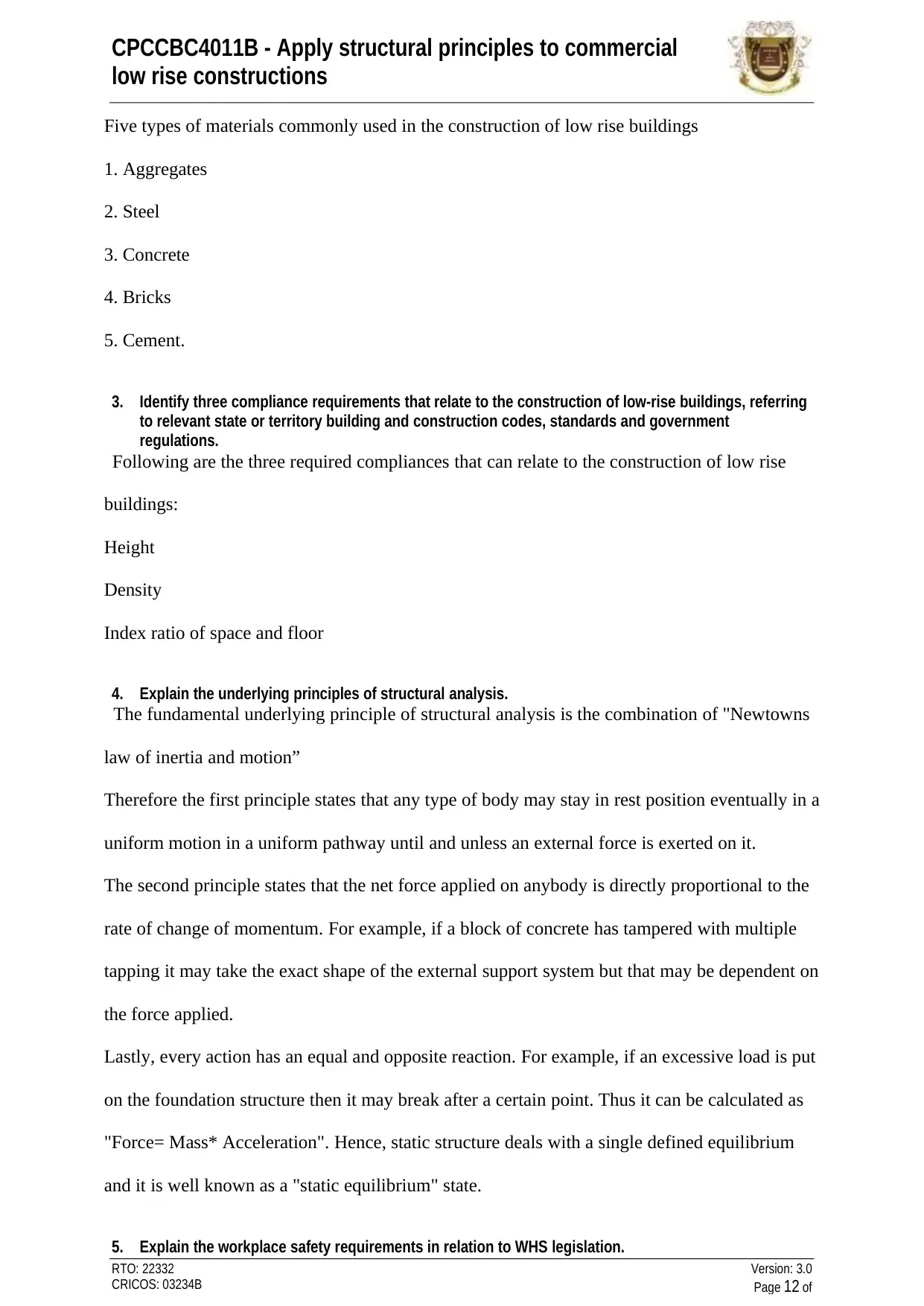
CPCCBC4011B - Apply structural principles to commercial
low rise constructions
RTO: 22332
CRICOS: 03234B
Version: 3.0
Page 12 of
Five types of materials commonly used in the construction of low rise buildings
1. Aggregates
2. Steel
3. Concrete
4. Bricks
5. Cement.
3. Identify three compliance requirements that relate to the construction of low-rise buildings, referring
to relevant state or territory building and construction codes, standards and government
regulations.
Following are the three required compliances that can relate to the construction of low rise
buildings:
Height
Density
Index ratio of space and floor
4. Explain the underlying principles of structural analysis.
The fundamental underlying principle of structural analysis is the combination of "Newtowns
law of inertia and motion”
Therefore the first principle states that any type of body may stay in rest position eventually in a
uniform motion in a uniform pathway until and unless an external force is exerted on it.
The second principle states that the net force applied on anybody is directly proportional to the
rate of change of momentum. For example, if a block of concrete has tampered with multiple
tapping it may take the exact shape of the external support system but that may be dependent on
the force applied.
Lastly, every action has an equal and opposite reaction. For example, if an excessive load is put
on the foundation structure then it may break after a certain point. Thus it can be calculated as
"Force= Mass* Acceleration". Hence, static structure deals with a single defined equilibrium
and it is well known as a "static equilibrium" state.
5. Explain the workplace safety requirements in relation to WHS legislation.
low rise constructions
RTO: 22332
CRICOS: 03234B
Version: 3.0
Page 12 of
Five types of materials commonly used in the construction of low rise buildings
1. Aggregates
2. Steel
3. Concrete
4. Bricks
5. Cement.
3. Identify three compliance requirements that relate to the construction of low-rise buildings, referring
to relevant state or territory building and construction codes, standards and government
regulations.
Following are the three required compliances that can relate to the construction of low rise
buildings:
Height
Density
Index ratio of space and floor
4. Explain the underlying principles of structural analysis.
The fundamental underlying principle of structural analysis is the combination of "Newtowns
law of inertia and motion”
Therefore the first principle states that any type of body may stay in rest position eventually in a
uniform motion in a uniform pathway until and unless an external force is exerted on it.
The second principle states that the net force applied on anybody is directly proportional to the
rate of change of momentum. For example, if a block of concrete has tampered with multiple
tapping it may take the exact shape of the external support system but that may be dependent on
the force applied.
Lastly, every action has an equal and opposite reaction. For example, if an excessive load is put
on the foundation structure then it may break after a certain point. Thus it can be calculated as
"Force= Mass* Acceleration". Hence, static structure deals with a single defined equilibrium
and it is well known as a "static equilibrium" state.
5. Explain the workplace safety requirements in relation to WHS legislation.
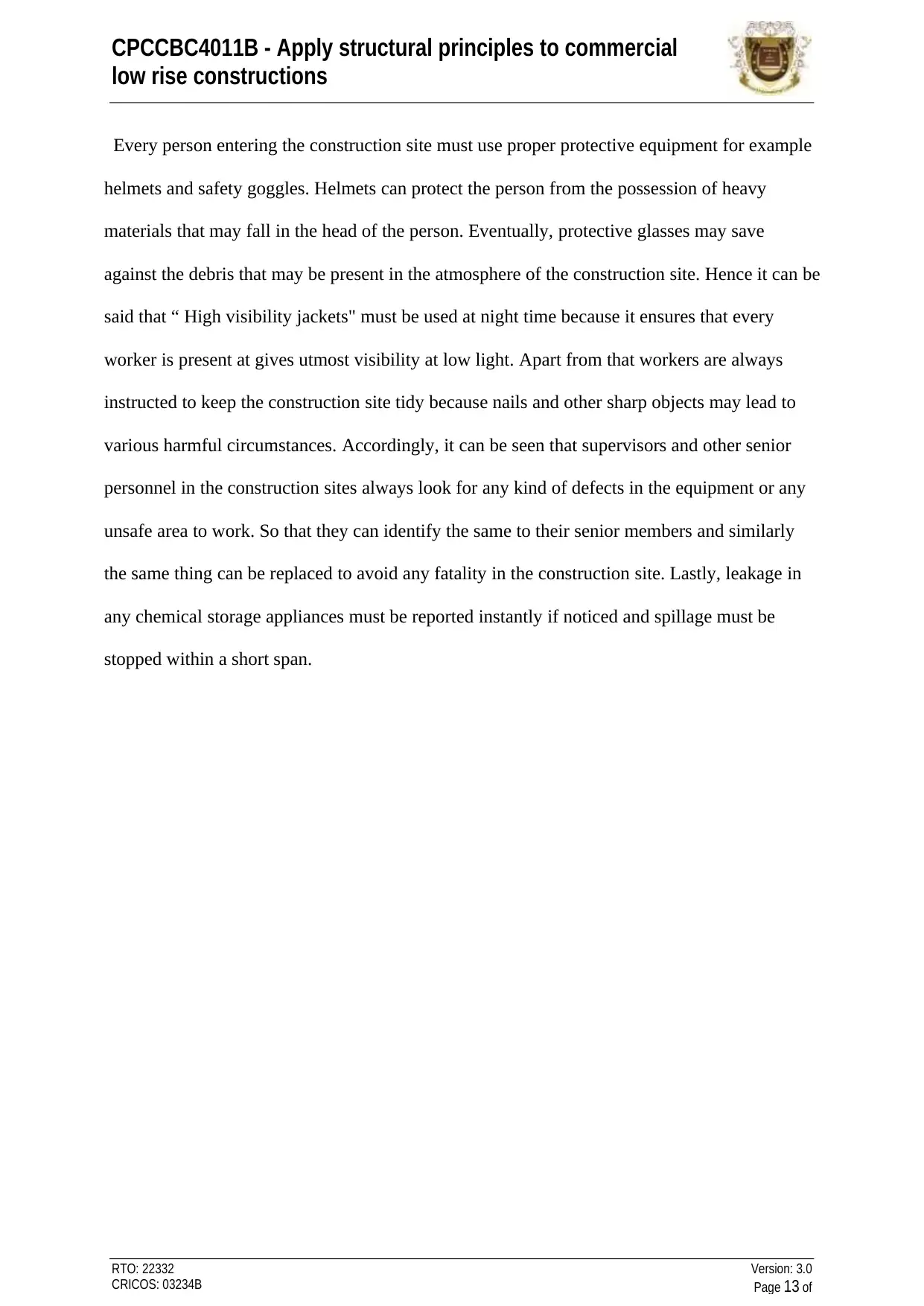
CPCCBC4011B - Apply structural principles to commercial
low rise constructions
RTO: 22332
CRICOS: 03234B
Version: 3.0
Page 13 of
Every person entering the construction site must use proper protective equipment for example
helmets and safety goggles. Helmets can protect the person from the possession of heavy
materials that may fall in the head of the person. Eventually, protective glasses may save
against the debris that may be present in the atmosphere of the construction site. Hence it can be
said that “ High visibility jackets" must be used at night time because it ensures that every
worker is present at gives utmost visibility at low light. Apart from that workers are always
instructed to keep the construction site tidy because nails and other sharp objects may lead to
various harmful circumstances. Accordingly, it can be seen that supervisors and other senior
personnel in the construction sites always look for any kind of defects in the equipment or any
unsafe area to work. So that they can identify the same to their senior members and similarly
the same thing can be replaced to avoid any fatality in the construction site. Lastly, leakage in
any chemical storage appliances must be reported instantly if noticed and spillage must be
stopped within a short span.
low rise constructions
RTO: 22332
CRICOS: 03234B
Version: 3.0
Page 13 of
Every person entering the construction site must use proper protective equipment for example
helmets and safety goggles. Helmets can protect the person from the possession of heavy
materials that may fall in the head of the person. Eventually, protective glasses may save
against the debris that may be present in the atmosphere of the construction site. Hence it can be
said that “ High visibility jackets" must be used at night time because it ensures that every
worker is present at gives utmost visibility at low light. Apart from that workers are always
instructed to keep the construction site tidy because nails and other sharp objects may lead to
various harmful circumstances. Accordingly, it can be seen that supervisors and other senior
personnel in the construction sites always look for any kind of defects in the equipment or any
unsafe area to work. So that they can identify the same to their senior members and similarly
the same thing can be replaced to avoid any fatality in the construction site. Lastly, leakage in
any chemical storage appliances must be reported instantly if noticed and spillage must be
stopped within a short span.
Paraphrase This Document
Need a fresh take? Get an instant paraphrase of this document with our AI Paraphraser
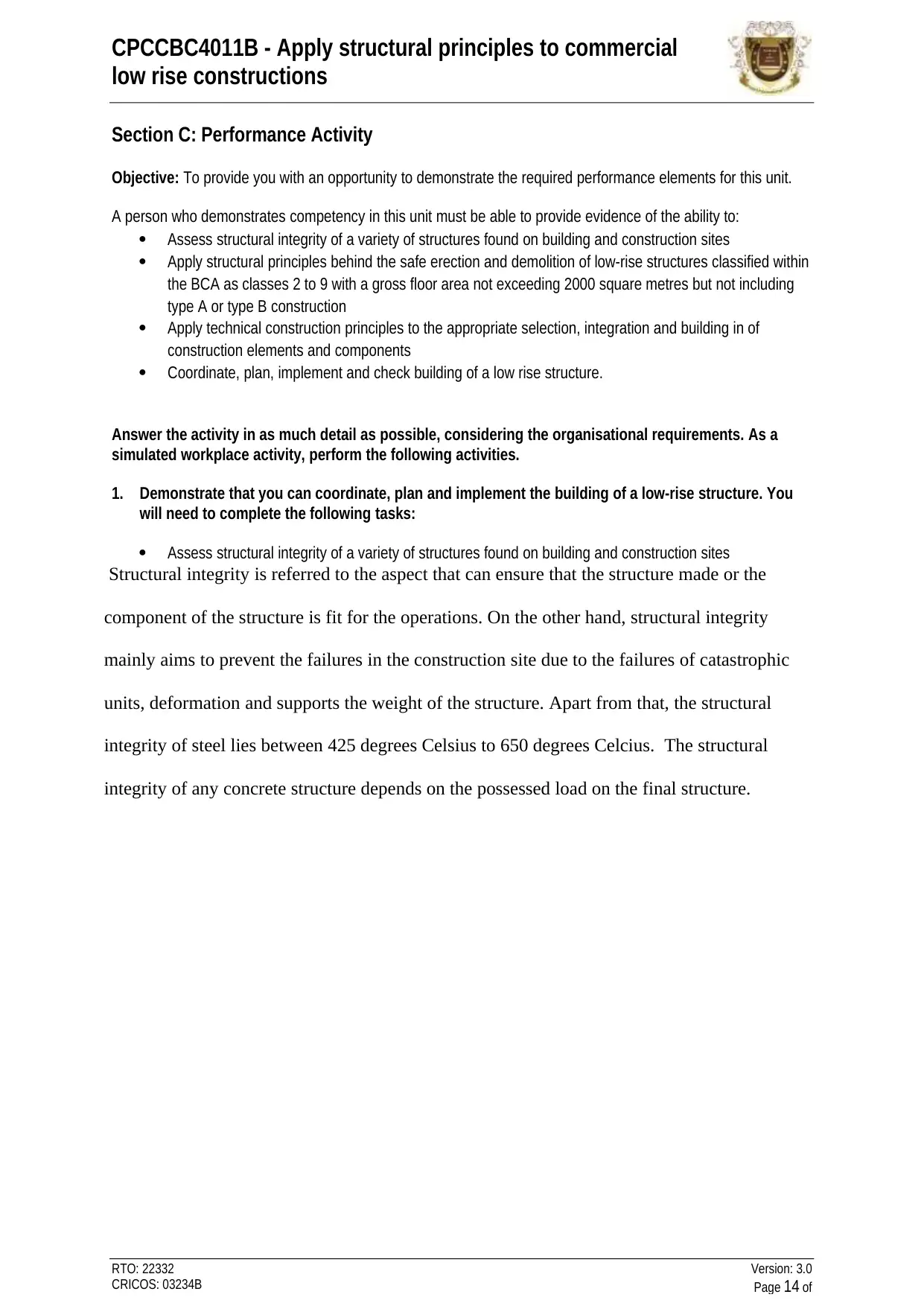
CPCCBC4011B - Apply structural principles to commercial
low rise constructions
RTO: 22332
CRICOS: 03234B
Version: 3.0
Page 14 of
Section C: Performance Activity
Objective: To provide you with an opportunity to demonstrate the required performance elements for this unit.
A person who demonstrates competency in this unit must be able to provide evidence of the ability to:
Assess structural integrity of a variety of structures found on building and construction sites
Apply structural principles behind the safe erection and demolition of low-rise structures classified within
the BCA as classes 2 to 9 with a gross floor area not exceeding 2000 square metres but not including
type A or type B construction
Apply technical construction principles to the appropriate selection, integration and building in of
construction elements and components
Coordinate, plan, implement and check building of a low rise structure.
Answer the activity in as much detail as possible, considering the organisational requirements. As a
simulated workplace activity, perform the following activities.
1. Demonstrate that you can coordinate, plan and implement the building of a low-rise structure. You
will need to complete the following tasks:
Assess structural integrity of a variety of structures found on building and construction sites
Structural integrity is referred to the aspect that can ensure that the structure made or the
component of the structure is fit for the operations. On the other hand, structural integrity
mainly aims to prevent the failures in the construction site due to the failures of catastrophic
units, deformation and supports the weight of the structure. Apart from that, the structural
integrity of steel lies between 425 degrees Celsius to 650 degrees Celcius. The structural
integrity of any concrete structure depends on the possessed load on the final structure.
low rise constructions
RTO: 22332
CRICOS: 03234B
Version: 3.0
Page 14 of
Section C: Performance Activity
Objective: To provide you with an opportunity to demonstrate the required performance elements for this unit.
A person who demonstrates competency in this unit must be able to provide evidence of the ability to:
Assess structural integrity of a variety of structures found on building and construction sites
Apply structural principles behind the safe erection and demolition of low-rise structures classified within
the BCA as classes 2 to 9 with a gross floor area not exceeding 2000 square metres but not including
type A or type B construction
Apply technical construction principles to the appropriate selection, integration and building in of
construction elements and components
Coordinate, plan, implement and check building of a low rise structure.
Answer the activity in as much detail as possible, considering the organisational requirements. As a
simulated workplace activity, perform the following activities.
1. Demonstrate that you can coordinate, plan and implement the building of a low-rise structure. You
will need to complete the following tasks:
Assess structural integrity of a variety of structures found on building and construction sites
Structural integrity is referred to the aspect that can ensure that the structure made or the
component of the structure is fit for the operations. On the other hand, structural integrity
mainly aims to prevent the failures in the construction site due to the failures of catastrophic
units, deformation and supports the weight of the structure. Apart from that, the structural
integrity of steel lies between 425 degrees Celsius to 650 degrees Celcius. The structural
integrity of any concrete structure depends on the possessed load on the final structure.

CPCCBC4011B - Apply structural principles to commercial
low rise constructions
RTO: 22332
CRICOS: 03234B
Version: 3.0
Page 15 of
Figure 4: Structural integrity of the reinforced structure
(Source: Forat, Przegalińska, & Krzemiński, 2021)
From the figure, it can be said that the integrity of the reinforced structure is dependent on the
two factors load and gravitational pull.
Apply structural principles behind the safe erection and demolition of low-rise structures classified within
the BCA as classes 2 to 9 with a gross floor area not exceeding 2000 square metres but not including
type A or type B construction
Following are the structural principles behind the safe erection a) Proper bracing for the
excessive storms and other natural calamities bracing for winds
b) Columns and footing
low rise constructions
RTO: 22332
CRICOS: 03234B
Version: 3.0
Page 15 of
Figure 4: Structural integrity of the reinforced structure
(Source: Forat, Przegalińska, & Krzemiński, 2021)
From the figure, it can be said that the integrity of the reinforced structure is dependent on the
two factors load and gravitational pull.
Apply structural principles behind the safe erection and demolition of low-rise structures classified within
the BCA as classes 2 to 9 with a gross floor area not exceeding 2000 square metres but not including
type A or type B construction
Following are the structural principles behind the safe erection a) Proper bracing for the
excessive storms and other natural calamities bracing for winds
b) Columns and footing
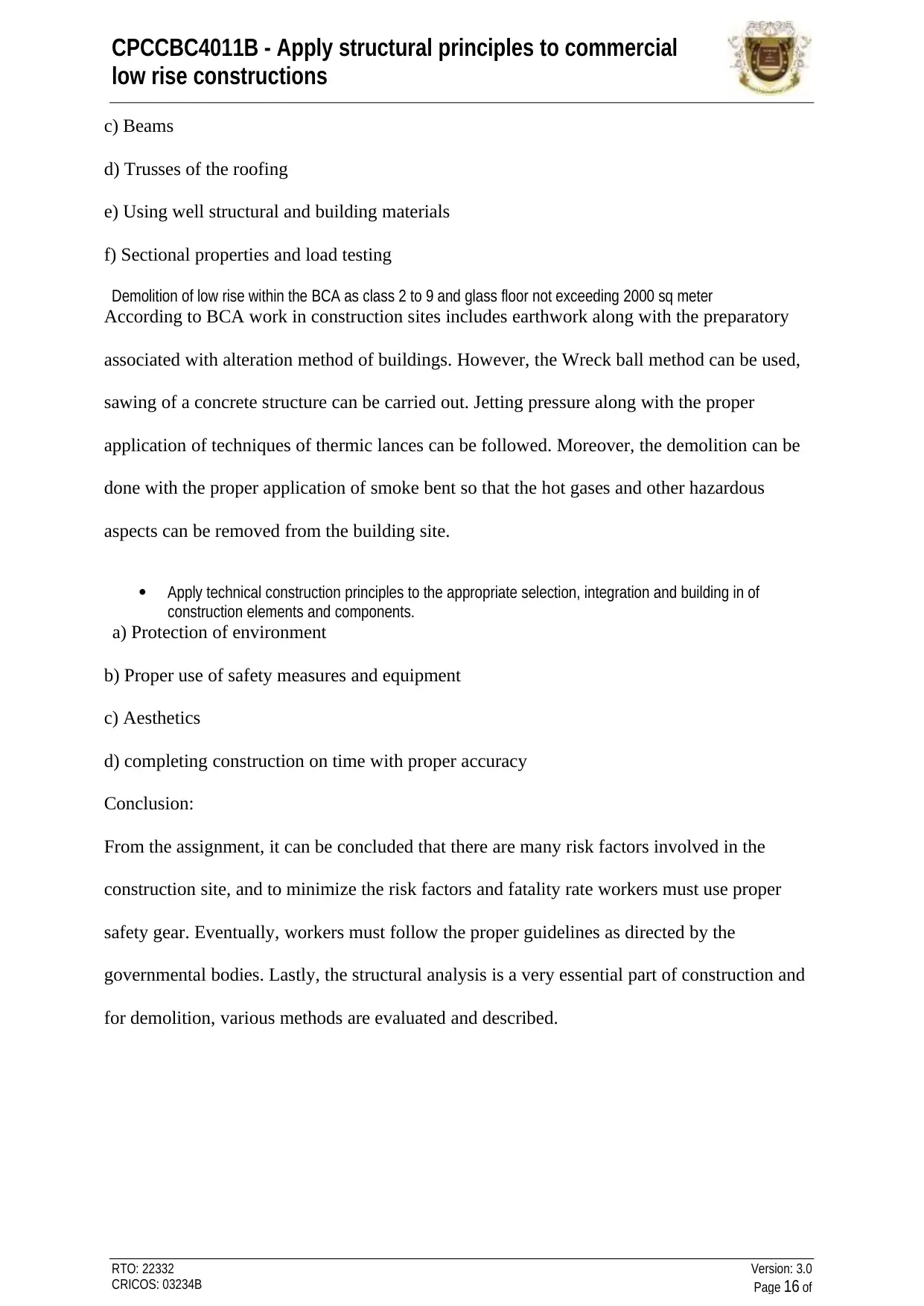
CPCCBC4011B - Apply structural principles to commercial
low rise constructions
RTO: 22332
CRICOS: 03234B
Version: 3.0
Page 16 of
c) Beams
d) Trusses of the roofing
e) Using well structural and building materials
f) Sectional properties and load testing
Demolition of low rise within the BCA as class 2 to 9 and glass floor not exceeding 2000 sq meter
According to BCA work in construction sites includes earthwork along with the preparatory
associated with alteration method of buildings. However, the Wreck ball method can be used,
sawing of a concrete structure can be carried out. Jetting pressure along with the proper
application of techniques of thermic lances can be followed. Moreover, the demolition can be
done with the proper application of smoke bent so that the hot gases and other hazardous
aspects can be removed from the building site.
Apply technical construction principles to the appropriate selection, integration and building in of
construction elements and components.
a) Protection of environment
b) Proper use of safety measures and equipment
c) Aesthetics
d) completing construction on time with proper accuracy
Conclusion:
From the assignment, it can be concluded that there are many risk factors involved in the
construction site, and to minimize the risk factors and fatality rate workers must use proper
safety gear. Eventually, workers must follow the proper guidelines as directed by the
governmental bodies. Lastly, the structural analysis is a very essential part of construction and
for demolition, various methods are evaluated and described.
low rise constructions
RTO: 22332
CRICOS: 03234B
Version: 3.0
Page 16 of
c) Beams
d) Trusses of the roofing
e) Using well structural and building materials
f) Sectional properties and load testing
Demolition of low rise within the BCA as class 2 to 9 and glass floor not exceeding 2000 sq meter
According to BCA work in construction sites includes earthwork along with the preparatory
associated with alteration method of buildings. However, the Wreck ball method can be used,
sawing of a concrete structure can be carried out. Jetting pressure along with the proper
application of techniques of thermic lances can be followed. Moreover, the demolition can be
done with the proper application of smoke bent so that the hot gases and other hazardous
aspects can be removed from the building site.
Apply technical construction principles to the appropriate selection, integration and building in of
construction elements and components.
a) Protection of environment
b) Proper use of safety measures and equipment
c) Aesthetics
d) completing construction on time with proper accuracy
Conclusion:
From the assignment, it can be concluded that there are many risk factors involved in the
construction site, and to minimize the risk factors and fatality rate workers must use proper
safety gear. Eventually, workers must follow the proper guidelines as directed by the
governmental bodies. Lastly, the structural analysis is a very essential part of construction and
for demolition, various methods are evaluated and described.
Secure Best Marks with AI Grader
Need help grading? Try our AI Grader for instant feedback on your assignments.
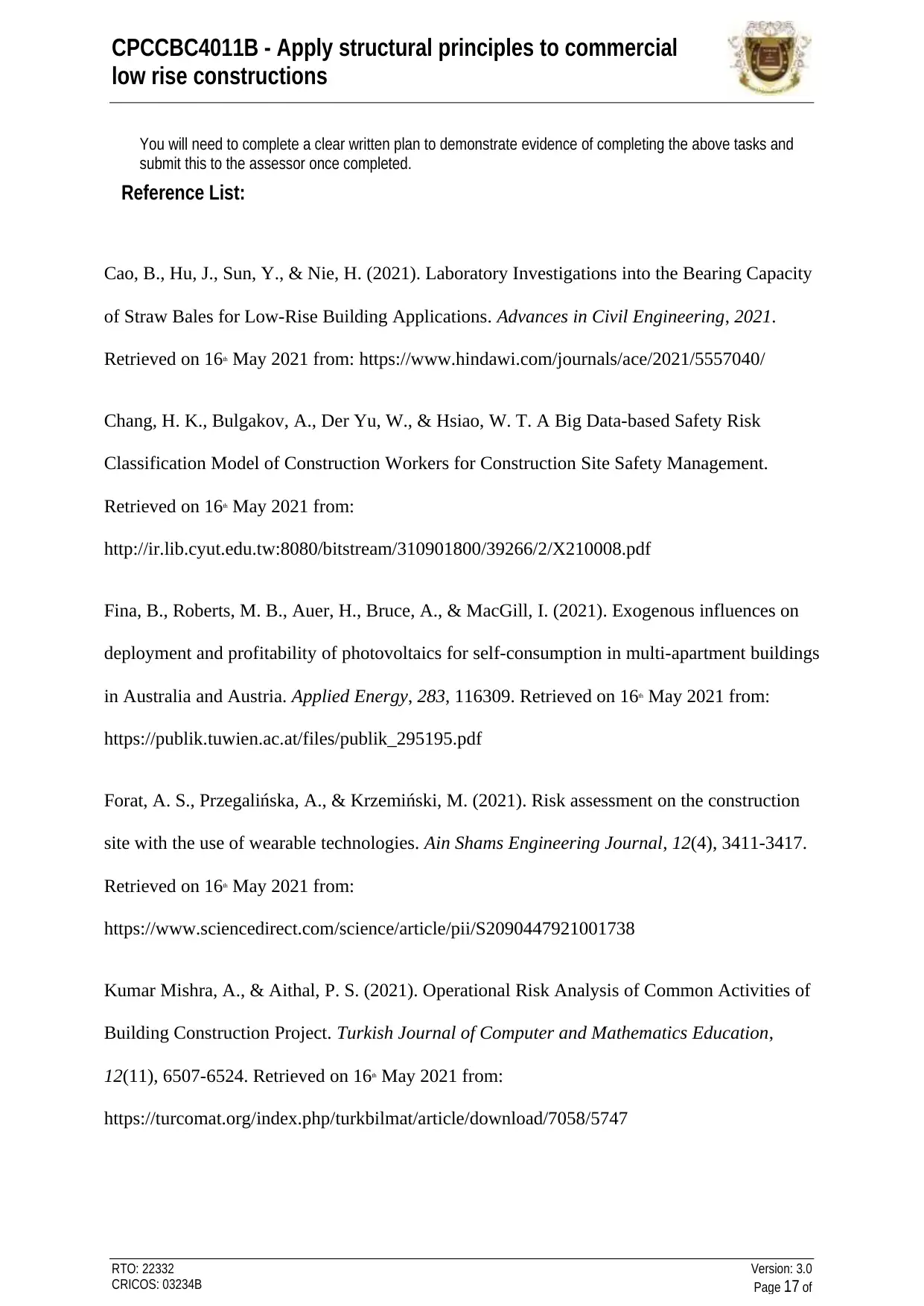
CPCCBC4011B - Apply structural principles to commercial
low rise constructions
RTO: 22332
CRICOS: 03234B
Version: 3.0
Page 17 of
You will need to complete a clear written plan to demonstrate evidence of completing the above tasks and
submit this to the assessor once completed.
Reference List:
Cao, B., Hu, J., Sun, Y., & Nie, H. (2021). Laboratory Investigations into the Bearing Capacity
of Straw Bales for Low-Rise Building Applications. Advances in Civil Engineering, 2021.
Retrieved on 16th May 2021 from: https://www.hindawi.com/journals/ace/2021/5557040/
Chang, H. K., Bulgakov, A., Der Yu, W., & Hsiao, W. T. A Big Data-based Safety Risk
Classification Model of Construction Workers for Construction Site Safety Management.
Retrieved on 16th May 2021 from:
http://ir.lib.cyut.edu.tw:8080/bitstream/310901800/39266/2/X210008.pdf
Fina, B., Roberts, M. B., Auer, H., Bruce, A., & MacGill, I. (2021). Exogenous influences on
deployment and profitability of photovoltaics for self-consumption in multi-apartment buildings
in Australia and Austria. Applied Energy, 283, 116309. Retrieved on 16th May 2021 from:
https://publik.tuwien.ac.at/files/publik_295195.pdf
Forat, A. S., Przegalińska, A., & Krzemiński, M. (2021). Risk assessment on the construction
site with the use of wearable technologies. Ain Shams Engineering Journal, 12(4), 3411-3417.
Retrieved on 16th May 2021 from:
https://www.sciencedirect.com/science/article/pii/S2090447921001738
Kumar Mishra, A., & Aithal, P. S. (2021). Operational Risk Analysis of Common Activities of
Building Construction Project. Turkish Journal of Computer and Mathematics Education,
12(11), 6507-6524. Retrieved on 16th May 2021 from:
https://turcomat.org/index.php/turkbilmat/article/download/7058/5747
low rise constructions
RTO: 22332
CRICOS: 03234B
Version: 3.0
Page 17 of
You will need to complete a clear written plan to demonstrate evidence of completing the above tasks and
submit this to the assessor once completed.
Reference List:
Cao, B., Hu, J., Sun, Y., & Nie, H. (2021). Laboratory Investigations into the Bearing Capacity
of Straw Bales for Low-Rise Building Applications. Advances in Civil Engineering, 2021.
Retrieved on 16th May 2021 from: https://www.hindawi.com/journals/ace/2021/5557040/
Chang, H. K., Bulgakov, A., Der Yu, W., & Hsiao, W. T. A Big Data-based Safety Risk
Classification Model of Construction Workers for Construction Site Safety Management.
Retrieved on 16th May 2021 from:
http://ir.lib.cyut.edu.tw:8080/bitstream/310901800/39266/2/X210008.pdf
Fina, B., Roberts, M. B., Auer, H., Bruce, A., & MacGill, I. (2021). Exogenous influences on
deployment and profitability of photovoltaics for self-consumption in multi-apartment buildings
in Australia and Austria. Applied Energy, 283, 116309. Retrieved on 16th May 2021 from:
https://publik.tuwien.ac.at/files/publik_295195.pdf
Forat, A. S., Przegalińska, A., & Krzemiński, M. (2021). Risk assessment on the construction
site with the use of wearable technologies. Ain Shams Engineering Journal, 12(4), 3411-3417.
Retrieved on 16th May 2021 from:
https://www.sciencedirect.com/science/article/pii/S2090447921001738
Kumar Mishra, A., & Aithal, P. S. (2021). Operational Risk Analysis of Common Activities of
Building Construction Project. Turkish Journal of Computer and Mathematics Education,
12(11), 6507-6524. Retrieved on 16th May 2021 from:
https://turcomat.org/index.php/turkbilmat/article/download/7058/5747
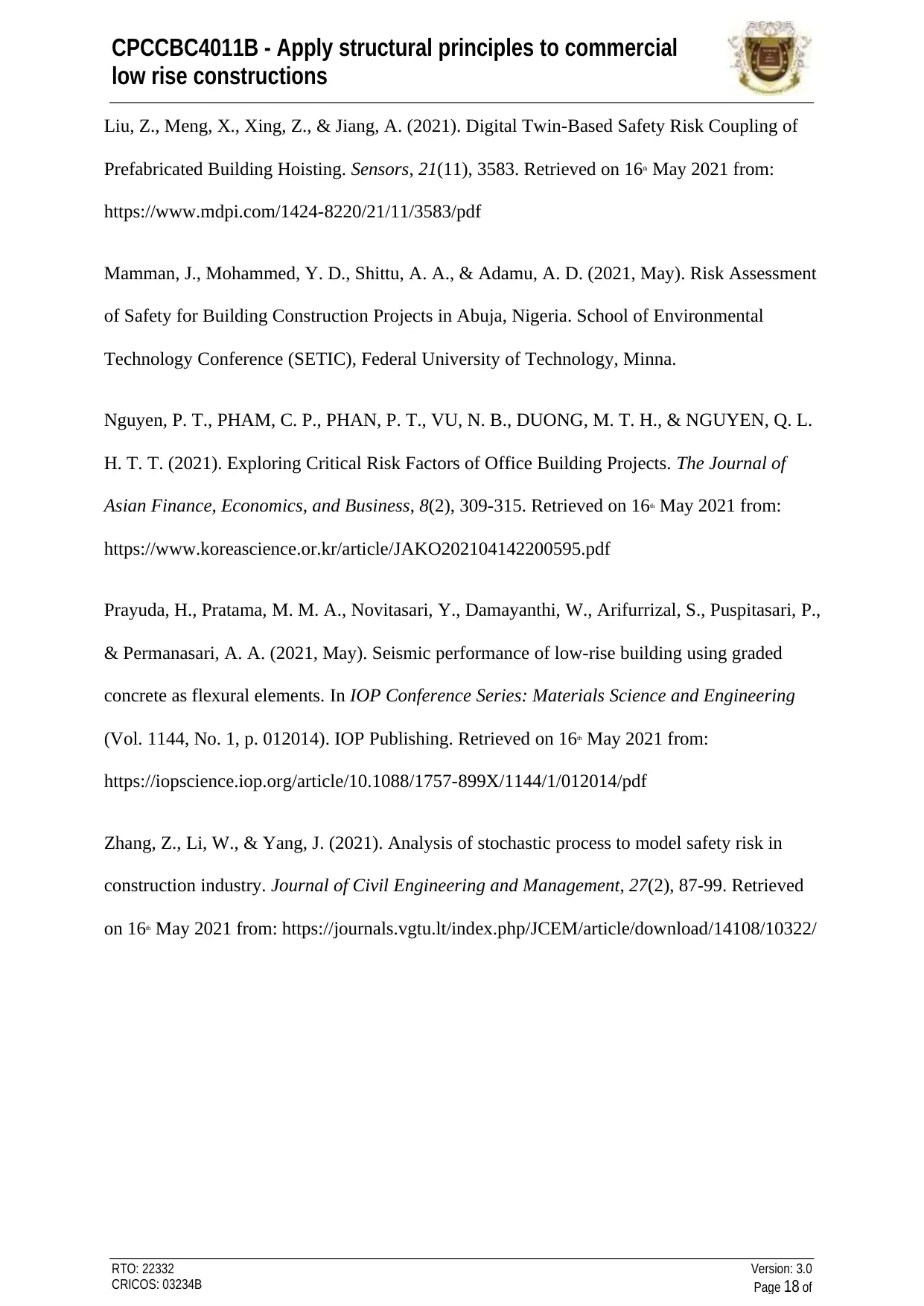
CPCCBC4011B - Apply structural principles to commercial
low rise constructions
RTO: 22332
CRICOS: 03234B
Version: 3.0
Page 18 of
Liu, Z., Meng, X., Xing, Z., & Jiang, A. (2021). Digital Twin-Based Safety Risk Coupling of
Prefabricated Building Hoisting. Sensors, 21(11), 3583. Retrieved on 16th May 2021 from:
https://www.mdpi.com/1424-8220/21/11/3583/pdf
Mamman, J., Mohammed, Y. D., Shittu, A. A., & Adamu, A. D. (2021, May). Risk Assessment
of Safety for Building Construction Projects in Abuja, Nigeria. School of Environmental
Technology Conference (SETIC), Federal University of Technology, Minna.
Nguyen, P. T., PHAM, C. P., PHAN, P. T., VU, N. B., DUONG, M. T. H., & NGUYEN, Q. L.
H. T. T. (2021). Exploring Critical Risk Factors of Office Building Projects. The Journal of
Asian Finance, Economics, and Business, 8(2), 309-315. Retrieved on 16th May 2021 from:
https://www.koreascience.or.kr/article/JAKO202104142200595.pdf
Prayuda, H., Pratama, M. M. A., Novitasari, Y., Damayanthi, W., Arifurrizal, S., Puspitasari, P.,
& Permanasari, A. A. (2021, May). Seismic performance of low-rise building using graded
concrete as flexural elements. In IOP Conference Series: Materials Science and Engineering
(Vol. 1144, No. 1, p. 012014). IOP Publishing. Retrieved on 16th May 2021 from:
https://iopscience.iop.org/article/10.1088/1757-899X/1144/1/012014/pdf
Zhang, Z., Li, W., & Yang, J. (2021). Analysis of stochastic process to model safety risk in
construction industry. Journal of Civil Engineering and Management, 27(2), 87-99. Retrieved
on 16th May 2021 from: https://journals.vgtu.lt/index.php/JCEM/article/download/14108/10322/
low rise constructions
RTO: 22332
CRICOS: 03234B
Version: 3.0
Page 18 of
Liu, Z., Meng, X., Xing, Z., & Jiang, A. (2021). Digital Twin-Based Safety Risk Coupling of
Prefabricated Building Hoisting. Sensors, 21(11), 3583. Retrieved on 16th May 2021 from:
https://www.mdpi.com/1424-8220/21/11/3583/pdf
Mamman, J., Mohammed, Y. D., Shittu, A. A., & Adamu, A. D. (2021, May). Risk Assessment
of Safety for Building Construction Projects in Abuja, Nigeria. School of Environmental
Technology Conference (SETIC), Federal University of Technology, Minna.
Nguyen, P. T., PHAM, C. P., PHAN, P. T., VU, N. B., DUONG, M. T. H., & NGUYEN, Q. L.
H. T. T. (2021). Exploring Critical Risk Factors of Office Building Projects. The Journal of
Asian Finance, Economics, and Business, 8(2), 309-315. Retrieved on 16th May 2021 from:
https://www.koreascience.or.kr/article/JAKO202104142200595.pdf
Prayuda, H., Pratama, M. M. A., Novitasari, Y., Damayanthi, W., Arifurrizal, S., Puspitasari, P.,
& Permanasari, A. A. (2021, May). Seismic performance of low-rise building using graded
concrete as flexural elements. In IOP Conference Series: Materials Science and Engineering
(Vol. 1144, No. 1, p. 012014). IOP Publishing. Retrieved on 16th May 2021 from:
https://iopscience.iop.org/article/10.1088/1757-899X/1144/1/012014/pdf
Zhang, Z., Li, W., & Yang, J. (2021). Analysis of stochastic process to model safety risk in
construction industry. Journal of Civil Engineering and Management, 27(2), 87-99. Retrieved
on 16th May 2021 from: https://journals.vgtu.lt/index.php/JCEM/article/download/14108/10322/
1 out of 18
Related Documents
Your All-in-One AI-Powered Toolkit for Academic Success.
+13062052269
info@desklib.com
Available 24*7 on WhatsApp / Email
![[object Object]](/_next/static/media/star-bottom.7253800d.svg)
Unlock your academic potential
© 2024 | Zucol Services PVT LTD | All rights reserved.





